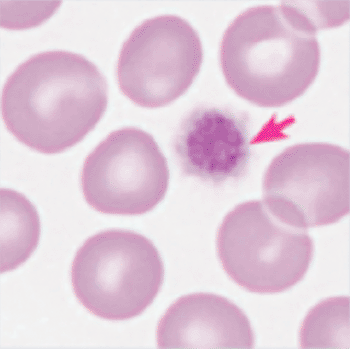Risk Factor Identified for Life-Threatening Disease in Premature Infants
By LabMedica International staff writers
Posted on 03 Feb 2014
Many premature infants suffer a life-threatening bowel infection called necrotizing enterocolitis (NEC), and a marker has been identified in those infants who are at risk for the infection.Posted on 03 Feb 2014
Since thrombocytopenia and bowel ischemia are consistent findings in advanced NEC, two potential biomarkers, reticulated platelets (RP) and intestinal alkaline phosphatase (iAP), were investigated.

Image: Giant platelet in a blood film (Photo courtesy of Sysmex).
Scientists at Loyola University Medical Center (Maywood, IL, USA) prospectively enrolled 177 infants born at less than 32 weeks' gestation and who were less than 1,500 grams in weight, from 2009 to 2012. Blood samples were collected from these infants within 72 hours of birth and weekly for four weeks to measure reticulated platelets (RP) and intestinal alkaline phosphatase (iAP). The percentage of reticulated platelets was determined by flow cytometry and serum iAP levels were determined by gel electrophoresis.
Of the 177 infants, 15 (8.5%) developed NEC and of these, 93% had low RP levels and 60% had high iAP. Those infants with low RP levels were significantly more likely to develop NEC while those with high iAP showed a similar trend. The study found that infants who would go on to develop NEC had significantly higher iAP levels at week four. While classically NEC occurs at week three of life, feeds of infants in the neonatal intensive care unit are advanced slowly and typically not started until near the end of the first week. The later initiation of feeds in the preterm infants in the study might be a reflection of them being extremely low birthweight infants (birthweight less than 1,000 g) and unstable at birth, delaying the onset of enteral feeds.
The authors concluded that as NEC affects up to 10% of very low birthweight infants, an already vulnerable population, it is important to discover reliable tests to detect those infants in this subpopulation who are most at risk of developing NEC in order to work towards prevention. Currently, no one test exists that can predict NEC; however, the team’s study suggests that the findings of low reticulated platelets and a high iAP may be useful in identifying those preterm infants at risk of NEC. Jonathan Muraskas, MD, the senior author, said, “Decreased reticulated platelets serve as a sensitive indicator for NEC onset. Further research also may find that infants with elevated iAP levels may be at risk.” The study was published online in the November 2013 issue of the Journal of Pediatric Surgery.
Related Links:
Loyola University Medical Center














